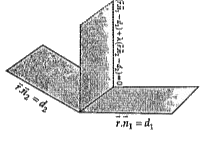Let P1:x−2y+3z=5andP2:2x−3y+z+4=0 be two planes. The equation of the plane perpendicular to the line of intersection to the line of intersection of P1=0 and P2= and passing through (1,1,1) is
11x−5y+7z−13=0
7x+5y+z=13
x+2y+z−4=0
x−2t+4z+3=0
The correct Answer is:B
To find the equation of the plane that is perpendicular to the line of intersection of the two given planes P1:x−2y+3z=5 and P2:2x−3y+z+4=0 and passes through the point (1,1,1), we can follow these steps:
Step 1: Identify the normal vectors of the planes
The normal vector of a plane given by the equation Ax+By+Cz=D is represented by the coefficients (A,B,C).
For P1:x−2y+3z=5:
- The normal vector n1=(1,−2,3).
For P2:2x−3y+z+4=0:
- The normal vector n2=(2,−3,1).
Step 2: Find a vector parallel to the line of intersection
The direction vector d of the line of intersection of the two planes can be found using the cross product of the normal vectors n1 and n2.
d=n1×n2=∣∣
∣∣ijk1−232−31∣∣
∣∣
Calculating the determinant:
d=i((−2)(1)−(3)(−3))−j((1)(1)−(3)(2))+k((1)(−3)−(−2)(2))
=i(−2+9)−j(1−6)+k(−3+4)
=7i+5j+1k
Thus, the direction vector d=(7,5,1).
Step 3: Find the normal vector of the required plane
The required plane is perpendicular to the line of intersection, which means its normal vector n is parallel to the direction vector d. Therefore, we can take:
n=(7,5,1)
Step 4: Write the equation of the plane
The equation of a plane with normal vector (a,b,c) passing through a point (x0,y0,z0) is given by:
a(x−x0)+b(y−y0)+c(z−z0)=0
Substituting a=7,b=5,c=1 and the point (1,1,1):
7(x−1)+5(y−1)+1(z−1)=0
Expanding this:
7x−7+5y−5+z−1=0
Combining like terms:
7x+5y+z−13=0
Final Equation
Thus, the equation of the required plane is:
7x+5y+z=13
The normal vector of a plane given by the equation Ax+By+Cz=D is represented by the coefficients (A,B,C).
- The normal vector n1=(1,−2,3).
- The normal vector n2=(2,−3,1).
The direction vector d of the line of intersection of the two planes can be found using the cross product of the normal vectors n1 and n2.
∣∣ijk1−232−31∣∣
∣∣
The required plane is perpendicular to the line of intersection, which means its normal vector n is parallel to the direction vector d. Therefore, we can take:
The equation of a plane with normal vector (a,b,c) passing through a point (x0,y0,z0) is given by:
Thus, the equation of the required plane is:
Topper's Solved these Questions
Similar Questions
Knowledge Check
The equation of the plane passing through the line of intersection of the planes x+y+z−6=0 and 2x+3y+4z+5=0 and passing through (1, 1,1)is
A20x+23y+26z=0B20x+23y+26z+69=0C20x+23y+26z−69=0DNone of the aboveThe equation of the plane through the line of intersection of the planes x + y + z - 1 = 0 and 2x + y - 3z + 2 = 0 passing through the point (1,1,1), is
Ax−4z+3=0Bx−y+z=1Cx+y+z=3D2x−y+z=2The equation of the line passing through (1,1,1) and perpendicular to the line of intersection of the planes x+2y−4z=0and2x−y+2z=0 is
Ax−15=1−y1=z−12Bx−1−5=1−y1=z−12Cx−10=1−y−10=z−1−5Dx−1−10=y+20=z−2−5
Find the equation of the plane passing through the line of intersection of the planes 2x−y=0 and 3z−y=0, and perpendicular to the plane 4x+5y−3z=9.
View SolutionLet P1:x+y+2z=3andP2:x−2y+z4 be two planes. Let A(2,45)andB(4,3,8) be two points in space. The equation of plane P3 through the line of intersection of P1andP2 such that the length of the projection upon it of the line segment AB is the least, is
View SolutionP1:x+3y−z=0andP2,y+2z=0 are two intersecting planes P3 is a plane passing through the point (2,1,-1) and through the line of intersection of P1andP2

Equation of P3 is
View SolutionThe equation of the plane passing through the line of intersection of the planes x+2y=3andy−2z+1=0 and perpendicular to the first plane is
View SolutionLet P1:x+y+2z−4=0andP2:2x−y+3z+5=0 be the planes. Let A(1,3,4)andB(3,2,7) be two points in space. The equation of a third plane P3 through the line of intersection of P1andP2 and parallel to AB is
View Solution
